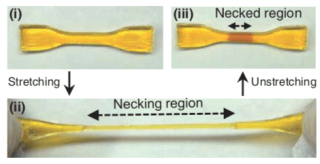Feb 1 2019
An approach inspired by the process accountable for muscle growth could result in the creation of stronger, longer-lasting materials.
 A double-network hydrogel (i). After stretching (ii), brittle sections break, allowing a generation of mechanoradicals, indicated by color change (iii). (Gong J. P. et al., Mechanoresponsive self-growing hydrogels inspired by muscle training, Science, February 1, 2019) (Image credit: Hokkaido University)
A double-network hydrogel (i). After stretching (ii), brittle sections break, allowing a generation of mechanoradicals, indicated by color change (iii). (Gong J. P. et al., Mechanoresponsive self-growing hydrogels inspired by muscle training, Science, February 1, 2019) (Image credit: Hokkaido University)
Scientists at Hokkaido University have formulated an approach to fabricate materials that become stronger in reaction to mechanical stress—imitating skeletal muscle growth. Their findings, reported in the journal Science, could lead to the creation of long-lasting materials that can adapt and reinforce based on surrounding circumstances.
The approach was inspired by the process that helps human skeletal muscles become robust. Owing to strength training at the gym, for instance, muscle fibers break down, promoting the creation of new, stronger fibers. For this to take place, the muscles must be provided with amino acids (building blocks of proteins), which combine together and create muscle fibers.
Jian Ping Gong from Hokkaido University is a polymer science expert. Her study team formulated a strategy using “double-network hydrogels” that imitates the building process of skeletal muscles.
Double-network hydrogels are a soft, yet sturdy material formed of around 85 wt% water and two types of polymer networks: one brittle and rigid, and the other soft and stretchable.
The researchers put a double-network hydrogel inside a solution containing molecules, known as monomers, which can be combined to form larger compounds called polymers. This solution imitates the role of circulating blood transporting amino acids to skeletal muscles.
When tensile force (stretching) is applied to the hydrogel, it causes some of its rigid and brittle polymer chains to break. This results in the development of a chemical species called “mechanoradicals” at the ends of the broken polymer chains. These mechanoradicals can activate the joining up of the monomer absorbed into the hydrogel from the nearby solution into a polymer network, thus fortifying the material.
With consecutive stretching, more breaking down and building up take place, like what takes place with skeletal muscles experiencing strength training. Due to this process, the hydrogel’s stiffness and strength improved 23 and 1.5 times, respectively, and the weight of the polymers grew by 86%. The team was additionally able to modify the material’s reaction to mechanical force by using a precise monomer that changed the gel’s reaction to heat; heated at high temperatures, the gel’s surface turned more water-resistant.
The scientists say their research could help with the progress of self-growing gel materials for use in flexible exosuits for patients dealing with skeletal injuries; these suits would potentially become sturdier and more practical the more they are used.
Since many types of DN gels have similar mechanical features, this process could be applied to a wide range of gels, expanding the range of potential applications.
Jian Ping Gong, Professor, Hokkaido University.
Mechanoresponsive self-growing hydrogels inspired by muscle training
This video shows the application of force via stretching on the hydrogels, and also outlines the overall procedures and aims of the research. (Copyright 2019, Hokkaido University)